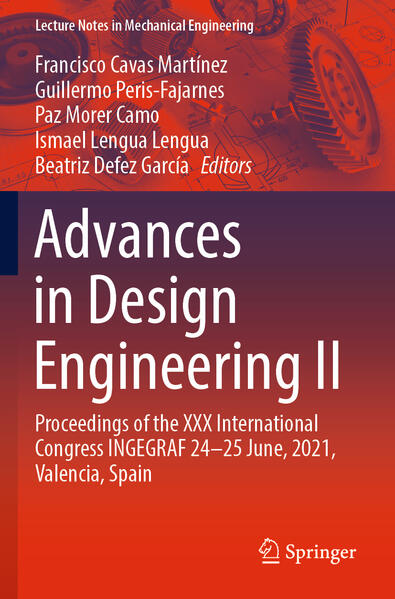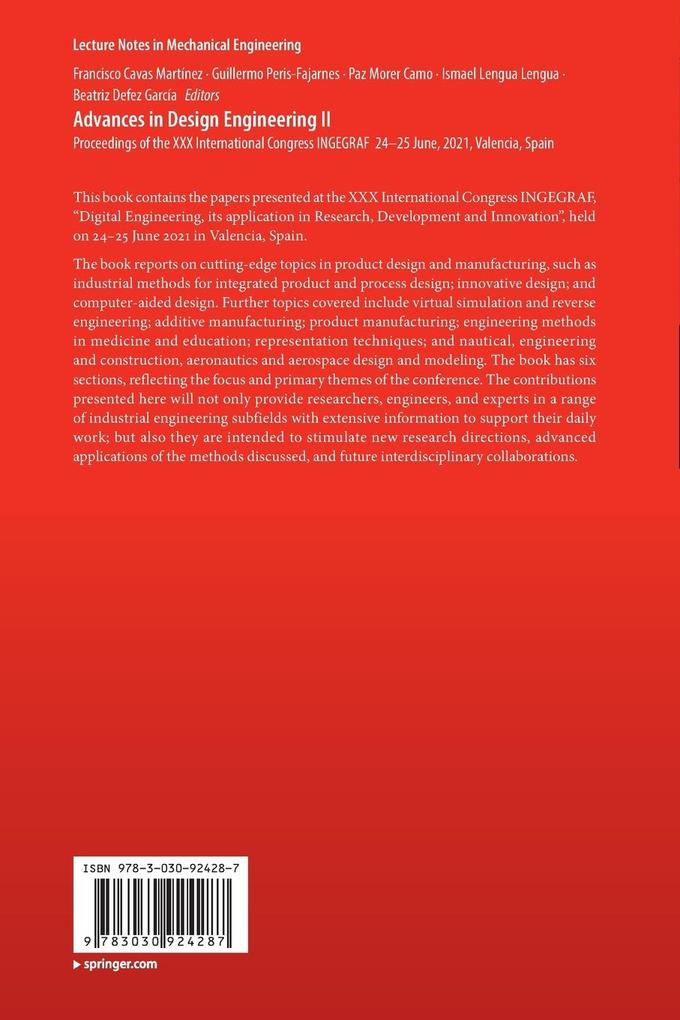
Zustellung: Di, 24.06. - Do, 26.06.
Versand in 2 Tagen
VersandkostenfreiBestellen & in Filiale abholen:
This book contains the papers presented at the XXX International Congress INGEGRAF, "Digital Engineering, its application in Research, Development and Innovation", held on 24-25 June 2021 in Valencia, Spain.
The book reports on cutting-edge topics in product design and manufacturing, such as industrial methods for integrated product and process design; innovative design; and computer-aided design. Further topics covered include virtual simulation and reverse engineering; additive manufacturing; product manufacturing; engineering methods in medicine and education; representation techniques; and nautical, engineering and construction, aeronautics and aerospace design and modeling. The book has six sections, reflecting the focus and primary themes of the conference. The contributions presented here will not only provide researchers, engineers, and experts in a range of industrial engineering subfields with extensive information to support their daily work; but also they are intended to stimulate new research directions, advanced applications of the methods discussed, and future interdisciplinary collaborations.
The book reports on cutting-edge topics in product design and manufacturing, such as industrial methods for integrated product and process design; innovative design; and computer-aided design. Further topics covered include virtual simulation and reverse engineering; additive manufacturing; product manufacturing; engineering methods in medicine and education; representation techniques; and nautical, engineering and construction, aeronautics and aerospace design and modeling. The book has six sections, reflecting the focus and primary themes of the conference. The contributions presented here will not only provide researchers, engineers, and experts in a range of industrial engineering subfields with extensive information to support their daily work; but also they are intended to stimulate new research directions, advanced applications of the methods discussed, and future interdisciplinary collaborations.
Inhaltsverzeichnis
Part 1 Preface and Acknowledgements & Organization CommitteePart I Engineering and Construction. New methodologies BIM. . - Digital representation of the terrain associated with an archaeological site: case study of the `Baker s House in Torreparedones. - Monitoring industrial plants from BIM models with Extended Reality. - IFC for Infrastructures: New open standards for intelligent data. - The digital simulation of the visual impact ofpower lines as a tool to optimize the design of the power line network. - Part II Product Design & Development. - Study of the interlayer behaviour of 3D printing materials and optimisation of an application. - Study of the application of gyroid structures in cyclist helmets. - Design of an ergonomic and inclusive hairdresser s washroom. - Part III Manufacturing and Industrial Process Design. - Fixing elements localization in aircraft largestructures using machine learning techniques. - Designof an autonomous monitoring system for oceans. - Part IV Graphical Bioengineering. - José Lapayese s silk-twisting lathe: Approach to its geometric modelling and 3D digital restitution. - José Lapayese s silk thread winding machine: Approach to its geometric modelling and 3D digital restitution. - Analysis of clinical thermal images for the detection of circulatory pathologies and venous insufficiency. - Variable complexity corneal surfaces characterization by modal geometrical reconstruction methods: Comparative Study. - Part V Innovation in Design. - Exploring novel teaching methods for design and engineering students in the field of nanomaterials. - Artisanal idea generation as a creative method in Higher Education. - State of the art of the impact of emergingtechnologies in Product Design. - Part VI Teaching Learning in Graphic Engineering. - Spatial Skills Training Proposal inVirtual Reality Learning Environments. - Development ofan application for the automaticevaluation of the quality of 3D CAD models. - Application of convergent technologies in teaching:Flipped Classroom and augmented reality. - BIM Workflows in the classroom: a topographicaland earthworks experience with Autodesk Revit®and AutoCAD Civil 3D®. - Topographic levelling from the point of viewof active learning using the flipped classroom model. - Didactic strategy based on experimental processand physical manipulation for a meaningfullearning of the dihedral system. - Coordination of subjects of the product design mention. - Motivational activity for presentation techniques.
Produktdetails
Erscheinungsdatum
09. Dezember 2022
Sprache
englisch
Auflage
1st edition 2022
Seitenanzahl
464
Reihe
Lecture Notes in Mechanical Engineering
Herausgegeben von
Francisco Cavas Martínez, Guillermo Peris-Fajarnes, Paz Morer Camo, Ismael Lengua Lengua, Beatriz Defez García
Verlag/Hersteller
Produktart
kartoniert
Abbildungen
XVI, 447 p. 304 illus., 278 illus. in color.
Gewicht
698 g
Größe (L/B/H)
235/155/25 mm
ISBN
9783030924287
Entdecken Sie mehr
Bewertungen
0 Bewertungen
Es wurden noch keine Bewertungen abgegeben. Schreiben Sie die erste Bewertung zu "Advances in Design Engineering II" und helfen Sie damit anderen bei der Kaufentscheidung.










